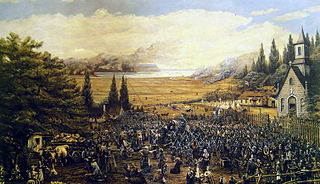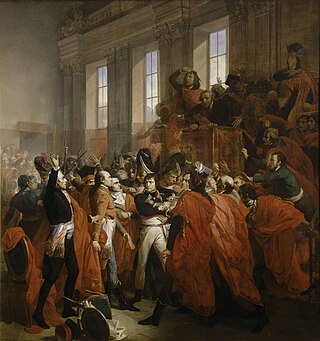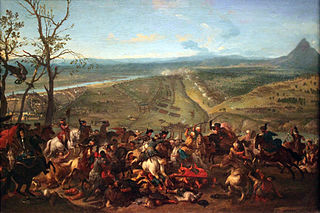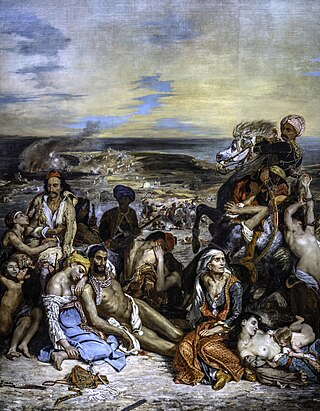Related Research Articles

1755 (MDCCLV) was a common year starting on Wednesday of the Gregorian calendar and a common year starting on Sunday of the Julian calendar, the 1755th year of the Common Era (CE) and Anno Domini (AD) designations, the 755th year of the 2nd millennium, the 55th year of the 18th century, and the 6th year of the 1750s decade. As of the start of 1755, the Gregorian calendar was 11 days ahead of the Julian calendar, which remained in localized use until 1923.
The 1710s decade ran from January 1, 1710, to December 31, 1719.

1716 (MDCCXVI) was a leap year starting on Wednesday of the Gregorian calendar and a leap year starting on Sunday of the Julian calendar, the 1716th year of the Common Era (CE) and Anno Domini (AD) designations, the 716th year of the 2nd millennium, the 16th year of the 18th century, and the 7th year of the 1710s decade. As of the start of 1716, the Gregorian calendar was 11 days ahead of the Julian calendar, which remained in localized use until 1923.

1637 (MDCXXXVII) was a common year starting on Thursday of the Gregorian calendar and a common year starting on Sunday of the Julian calendar, the 1637th year of the Common Era (CE) and Anno Domini (AD) designations, the 637th year of the 2nd millennium, the 37th year of the 17th century, and the 8th year of the 1630s decade. As of the start of 1637, the Gregorian calendar was 10 days ahead of the Julian calendar, which remained in localized use until 1923.

1799 (MDCCXCIX) was a common year starting on Tuesday of the Gregorian calendar and a common year starting on Saturday of the Julian calendar, the 1799th year of the Common Era (CE) and Anno Domini (AD) designations, the 799th year of the 2nd millennium, the 99th year of the 18th century, and the 10th and last year of the 1790s decade. As of the start of 1799, the Gregorian calendar was 11 days ahead of the Julian calendar, which remained in localized use until 1923.

1717 (MDCCXVII) was a common year starting on Friday of the Gregorian calendar and a common year starting on Tuesday of the Julian calendar, the 1717th year of the Common Era (CE) and Anno Domini (AD) designations, the 717th year of the 2nd millennium, the 17th year of the 18th century, and the 8th year of the 1710s decade. As of the start of 1717, the Gregorian calendar was 11 days ahead of the Julian calendar, which remained in localized use until 1923.

Johann Joachim Winckelmann was a German art historian and archaeologist. He was a pioneering Hellenist who first articulated the differences between Greek, Greco-Roman and Roman art. "The prophet and founding hero of modern archaeology", Winckelmann was one of the founders of scientific archaeology and first applied the categories of style on a large, systematic basis to the history of art. Many consider him the father of the discipline of art history. He was one of the first to separate Greek Art into periods, and time classifications.

Philhellenism was an intellectual movement prominent mostly at the turn of the 19th century. It contributed to the sentiments that led Europeans such as Lord Byron, Charles Nicolas Fabvier and Richard Church to advocate for Greek independence from the Ottoman Empire.

Georg Zoëga was a Danish scientist. He was noted for his work as an archaeologist, numismatist and anthropologist.

Jean-Jacques Barthélemy was a French Catholic clergyman, archaeologist, numismatologist and scholar who became the first person to decipher an extinct language. He deciphered the Palmyrene alphabet in 1754 and the Phoenician alphabet in 1758.

James "Athenian" Stuart was a Scottish archaeologist, architect and artist, best known for his central role in pioneering Neoclassicism.
Below are notable events in archaeology that occurred in 1845.
The decade of the 1700s in archaeology involved some significant events.
The decade of the 1760s in archaeology involved some significant events.
The decade of the 1780s in archaeology involved some significant events.
The decade of the 1790s in archaeology involved some significant events.
Events from the year 1803 in France.
James Millingen, was a Dutch-English archaeologist and numismatist.

Travels of Anacharsis the Younger in Greece was a fictional work about the travels of the Scythian named Anacharsis in Greece in the middle of the 4th century BCE, written by Jean-Jacques Barthélemy and published in 1788.
References
- ↑ Caruana, Antonio Annetto (1882). Report on the Phoenician and Roman antiquities in the group of the islands of Malta. Malta: Government Printing Office. p. 89.
- ↑ Ghosh, Pallab (2022-11-24). "Gold coin proves 'fake' Roman emperor was real". BBC News . Retrieved 2022-11-24.
- ↑ "Mercati, Michele 1541-1593". worldcat.org. Retrieved 8 June 2017.
- ↑ "James 'Athenian' Stuart, 1713-1788". Telegraph.co.uk. Retrieved 8 June 2017.
- ↑ "Jean-Jacques Barthelemy - French archaeologist". Encyclopedia Britannica. Retrieved 17 May 2017.
- ↑ "Johann Winckelmann - German art historian". Encyclopedia Britannica. Retrieved 10 June 2017.
- ↑ "LC Linked Data Service: Authorities and Vocabularies (Library of Congress)". id.loc.gov. Retrieved 17 May 2017.